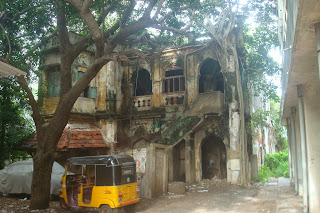Once upon a time, WIMCO was an iconic brand, at the very least in the Tiruvottiyur area. It was one of the earliest factories there. The company itself was incorporated in 1923; the factory at Madras used to make matches, which was what the company was known for, so it is likely that its presence at Tiruvottiyur goes back to the first half of the 20th century.
I don't remember much about the factory, even though I had visited it a couple of times. But I remember this building on Tiruvottiyur High Road very well, since I passed it every day for a couple of years or so. WIMCO itself went through a very tough time in the late 1990s and early 2000s, with industrial unrest being almost a standard feature of its operations. Almost all the workers at Tiruvottiyur left. Wimco Workers Union was without a raison d'être. The building came to be used for other businesses.
Once this building goes - as it is bound to, soon, - there will be little left of WIMCO in this place. The last survivors will be the residential area, still called Wimco Nagar, and the suburban railway station of the same name. Wimco will pass into history!















